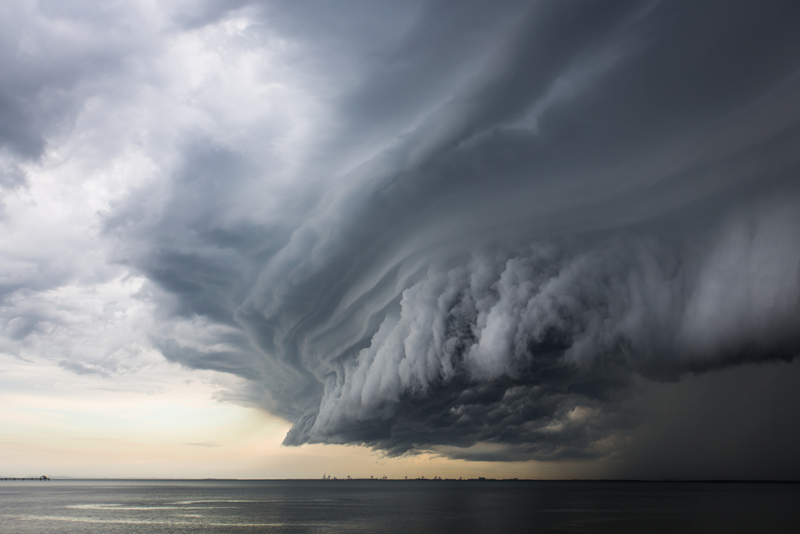Drops Falling in Clouds Make More Drops
Atmospheric scientists remain perplexed about the causes of abrupt rainstorms, in part because real clouds are too complicated for controlled laboratory experiments. But a research team has now created an analog atmosphere in a small chamber and discovered a process that could have an influence on precipitation. They found that a cold drop falling through their model atmosphere generates a stream of microdroplets in its wake. In real clouds, such droplets could merge to form rain or could travel on air currents to seed the formation of further droplets elsewhere, exerting a powerful influence on the evolution of clouds.
Weather and rain are difficult to study with computer models or in lab experiments because in both cases it is hard to create realistic atmospheric conditions. So researchers have largely relied on hard-to-control measurements in the field, such as experiments 50 years ago, where dry ice granules dropped into clouds were found to unleash torrents of rain and cloud formation. The explanation of this effect—and whether it is linked to ordinary rain—remains mysterious.
Now a team led by Eberhard Bodenschatz of the Max Planck Institute for Dynamics and Self-Organization in Göttingen, Germany, has managed to create a similar rain-seeding phenomenon in controlled laboratory conditions. To mimic the atmosphere, the researchers put a mixture of sulfur hexafluoride ( SF6) and helium into a chamber made of two horizontal, parallel, 6-cm-square plates separated by about 2 cm and sealed around the sides. The SF6 played the role of atmospheric water—it could be either liquid or vapor, depending on the temperature. The helium played the role of the other gases in the atmosphere, such as nitrogen.
The researchers heated the lower plate and cooled the upper plate. Under the right conditions, they found that this mixture naturally formed into a lower sea of liquid SF6, with a mixture of helium and SF6 vapor resting above it. Some SF6 also condensed on the cold surface of the upper plate and occasionally shed drops that fell down through the gaseous atmosphere to the liquid below.
Since the cloud seeding experiments many years ago, scientists have wondered why a falling ice crystal or cold liquid drop might trigger the formation of more droplets, says graduate student and team member Prasanth Prabhakaran. In their chamber, the researchers could closely track falling drops and found that many other smaller droplets typically formed in their wake. The effect arises, they argue, because a cold drop, as it passes through a region of vapor, cools the vapor slightly, causing some liquid to condense as tiny droplets. The team backs up their hypothesis with thermodynamic calculations.
Bodenschatz and colleagues also performed related experiments under slightly different conditions in which no lower sea of liquid formed. In this case, the droplets produced in the wake of falling drops created a stable horizontal layer of mist above a fixed altitude, with pure gas below—essentially a cloud layer. The gas mixture, the researchers argue, was acting like the atmosphere in which the relative humidity increases with height. Above a certain critical height, the effective SF6 “humidity” was high enough that droplets, once created, would then tend to grow. Lower down, at lower humidity, such droplets instead evaporate, leaving no cloud.
The researchers suggest that these phenomena—droplet seeding and cloud formation—accurately mimic the Earth’s atmosphere. They may significantly influence when rain falls and how clouds and storms develop over time. However, the team also says that making a detailed connection will take more work. The atmosphere hosts turbulent fluid motions and strong updrafts, making everything more complex. Dust and other particles in the atmosphere also play a key role in droplet nucleation, whereas droplets in the experiments formed on their own.
The work is an important step in basic atmospheric science, says meteorologist Juan Pedro Mellado of the Max Planck Institute for Meteorology in Hamburg. “Doing a similar experiment in atmospheric conditions is difficult” because it’s hard to reproduce the right environmental conditions on a small scale or to closely monitor the wake behind the drop. He says the work provides “a clear example of how laboratory experiments of idealized problems can help us better understand atmospheric processes.”
This research is published in Physical Review Letters.
–Mark Buchanan
Mark Buchanan is a freelance science writer who splits his time between Abergavenny, UK, and Notre Dame de Courson, France.





